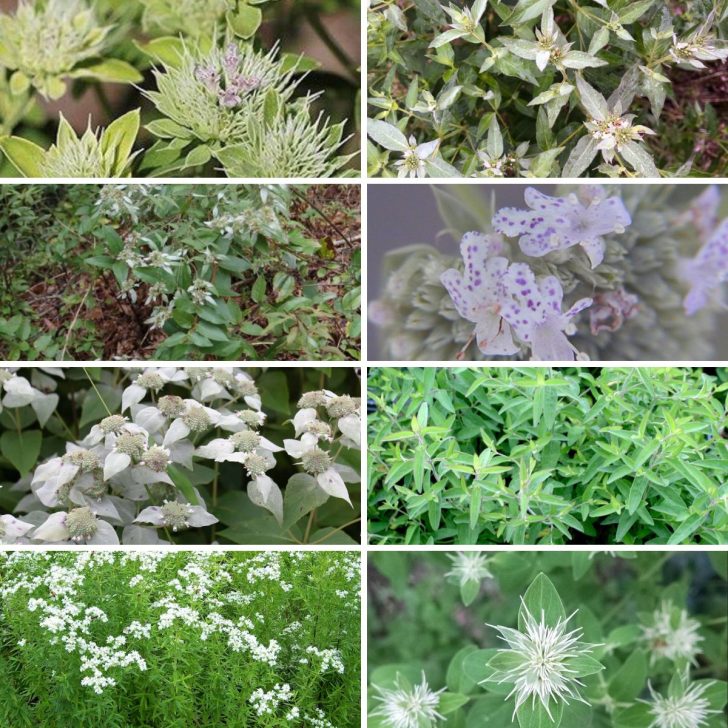We had no idea just how challenging it was going to be correctly identify the different varieties of mountain mint. So if you see any discrepancies in names versus photos or information, please do let us know so that we can quickly correct it.
Our ancestors and ancients named many of these plants by description. They used them for cooking and remedies without ever knowing the scientific names, and sometimes even before it may have been assigned a unique botanical name.
The Challenge of Common Names and Many Varieties
For example, Narrowleaf Mountain Mint,” “Slim Leaf Mountain Mint,” and “Long Leaved Mountain Mint” are all common names that have been used to refer to Pycnanthemum tenuifolium. It’s characterized by its narrow, slender leaves, which likely gave rise to various common names.
E.g., “Son, go pick me some of that slim leaf mint to make tea for your sisters upset tummy.”
Common names for plants can sometimes be regional or colloquial and may vary from place to place, leading to a single species having several different common names. This is one of the reasons why botanical names, which are standardized and internationally recognized, are so important in accurately identifying plants.
To further complicate different matters, sometimes different species can also share similar common names, which can lead to confusion. For this reason, when you are looking for specific plant information or purchasing plants, it’s always a good idea to verify the botanical name to ensure you’re getting the correct species.
A Literal Return to Our Roots
As civilization moved away from our “roots”, where plant lore was second nature, most of us have lost (or actually, never grew up knowing) that connection. Now, as many of us are returning increasingly toward rediscovering the rich heritage of plant medicine, the scientific names help us in properly identifying plants and then learning about them.
Mountain Mint – an Intensely Flavorful Mint
Mountain mint is an intensely flavorful plant whose blossoms rate best results in attracting garden friendly pollinators. Favored amongst gardeners, herbalists, and nature enthusiasts, this member of the Lamiaceae family is one of the best mint plants to grow for flavor and for your yard and garden ecosystem.
Culinary Uses
Just like other types of mint, potent mint has numerous culinary uses. The leaves are often used to make teas, refreshing smoothies and as garnish for cocktails and other beverages. The fresh, minty flavor can provide a refreshing twist to salads, soups, and desserts and is also popular for making jelly.
Medicinal Uses
Mountain mint has traditionally been used for its medicinal properties. It contains pulegone, which is a potent antiseptic. The plant has been used for treating colds and flu, as it may help to clear congestion and soothe sore throats.
It’s also been used for digestive issues, as the mint can help to soothe upset stomachs and reduce gas. Additionally, mountain mint may also have mild sedative properties, potentially aiding in sleep or relaxation.
Ecological Uses
Mountain mint is great for attracting pollinators. Its blooms are highly attractive to bees, butterflies, and other beneficial insects. This makes it an excellent addition to gardens designed to support local ecosystems.
Mountain Mint Ranks Highest in Penn State Pollinator Study 2013
The Penn State Pollinator Trial[1]https://extension.psu.edu/programs/master-gardener/counties/lancaster/pollinator-friendly-garden-certification/pollinator-trial-results-2013 is an extensive research project that evaluates various plant species for their attractiveness to pollinators. In 2013, some mountain mint varieties were amongst the top performers in multiple categories.
STUDY SHOWS MOUNTAIN MINT TO BE MOST VISITED BY:
- Pollinators (cumulative visits): Short-toothed Mountain Mint (Pycnanthemum muticum) was among the top plants visited by all types of pollinators, showing its broad appeal.
- Bees: Short-toothed Mountain Mint (Pycnanthemum muticum) again ranked highly in this category, indicating that it is particularly attractive to bees.
- Butterflies: Cluster Mountain Mint (Pycnanthemum muticum) performed well in this category, attracting a high number of butterflies.
- Beneficial Wasps: Short-toothed Mountain Mint (Pycnanthemum muticum) was found to be highly attractive to beneficial wasps, insects that help control pest populations.
- Other Beneficial Insects: Mountain mints as a group performed well in this category, attracting a range of beneficial insects, such as hoverflies and lacewings, that provide natural pest control.
These results confirm that mountain mint is a valuable addition to gardens designed to attract and support pollinators, which contribute significantly to your yard and garden ecosystems.[2]https://extension.psu.edu/programs/master-gardener/counties/lancaster/pollinator-friendly-garden-certification/pollinator-trial-results-2013
Differences from Other Mints
While mountain mint shares many properties with other common garden mints, there are some notable differences. For instance, while most mints are known for their invasiveness, some varieties of mountain mint are more controlled, making them easier to incorporate into a garden without them taking over.
Furthermore, mountain mints tend to have a slightly different aroma and taste compared to other mints. While they still have the characteristic minty freshness, it is often described as being somewhat sharper and more intense. This can make mountain mint a great choice for those who want a stronger mint flavor in their dishes or herbal teas.
Mountain mint also stands out in its attraction to pollinators. While many mints do attract bees and butterflies, mountain mints are particularly appealing to a wide range of pollinators. This, combined with their often showy flowers, makes them a particularly valuable addition to pollinator gardens.
Finally, mountain mints are typically more tolerant of a variety of soil conditions than some other mints, that prefer rich, moist soils. This can make it a better choice for gardeners dealing with difficult soil conditions.
Mountain mints are a popular choice for gardeners and herb enthusiasts, loved for their fragrant foliage, lovely flowers, and appealing to various pollinators. There are around 20 varieties of mountain mint with the narrow leaf and Virginia mountain mints as most often cited as the generic “mountain mint”.
The 10 Most Popular Mountain Mint Varieties
EDITOR’S NOTE: Just as information was hard to find, accurately identified images were also hard to find for some of the plants, and some did not have a source to tribute, (or it was lost in the confusion!). So again, if you note any discrepancies, please do send us a message so we can fix it right away.
The Meaning of the Scientific Names of These Mountain Mint Varieties
Pycnanthemum, the genus name of these Mountain Mints, comes from the Greek words ‘pyknos’ meaning dense, and ‘anthemon’ meaning flower, referencing the densely packed clusters of flowers these species produce.
Here’s an abbreviated list of these varieties with more expanded information following that should you wish for more.
- Appalachian Mountain Mint (Pycnanthemum flexuosum) – ‘Flexuosum’ comes from the Latin word meaning ‘bending’ or ‘curvy,’ thought to refer to the flexibility of the plants stems, or else the pleasingly curved shape of its leaves.
- Beadle’s Mountain Mint (Pycnanthemum beadlei) – Named after Beadle, an American botanist, who is recognized for his work in the 19th and 20th centuries.
- Broadleaf Mountain Mint (Pycnanthemum latifolium) – ‘Latifolium’ is derived from the Latin words ‘latus’ meaning ‘wide,’ and ‘folium’ meaning ‘leaf,’ referring to the broad leaves of this variety.
- Cluster Mountain Mint (Pycnanthemum muticum) – ‘Muticum’ comes from the Latin word ‘muticus’ meaning ‘blunt’ or ‘truncated,’ potentially referring to the shape of the leaves or flowers.
- Hairy Mountain Mint (Pycnanthemum pilosum) – ‘Pilosum’ is derived from the Latin word ‘pilosus’ meaning ‘hairy,’ referring to the hairy leaves and stems of this variety.
- Hoary Mountain Mint (Pycnanthemum incanum) – ‘Incanum’ is derived from the Latin word ‘incanus’ meaning ‘gray’ or ‘hoary,’ referring to the grayish appearance of this plant due to its hairy leaves and stems.
THESE NEXT TWO MAY BE THE SAME PLANT: - Long-leaved Mountain Mint (Pycnanthemum longifolium) – ‘Longifolium’ comes from the Latin words ‘longus’ meaning ‘long,’ and ‘folium’ meaning ‘leaf,’ referencing the long leaves of this variety.
- Narrowleaf (aka Slender Leaf) Mountain Mint (Pycnanthemum tenuifolium) – ‘Tenuifolium’ comes from the Latin words ‘tenuis’ meaning ‘thin’ or ‘slender,’ and ‘folium’ meaning ‘leaf,’ referencing the narrow leaves of this variety.
- Short Toothed (aka Wild Basil) Mountain Mint (Pycnanthemum clinopodioides) – ‘Clinopodioides’ refers to the resemblance to the Clinopodium genus, or ‘wild basil.’
- Virginia Mountain Mint (Pycnanthemum virginianum) – ‘Virginianum’ refers to Virginia, the state where this variety was first recorded.
And below is some expanded information on this list of the top 10 mountain mint varieties in North America.
Mountain Mint Features and General Growing Information
Appalachian Mountain Mint (Pycnanthemum flexuosum)
- Hardiness Zone: 4-8
- Bloom Time: June to September
- Harvest Time: Late summer
- Sun: Full to partial
- Water: Moderate
- Soil: Well-drained, can tolerate a variety of soil types
- Invasive: Can be moderately aggressive if not controlled
The Appalachian Mountain Mint is a native North American perennial that typically grows up to 3 feet tall. The plant produces clusters of white flowers in a unique spikey ball shape. that have a speckling of purple spots, attracting a variety of pollinators throughout the blooming season.

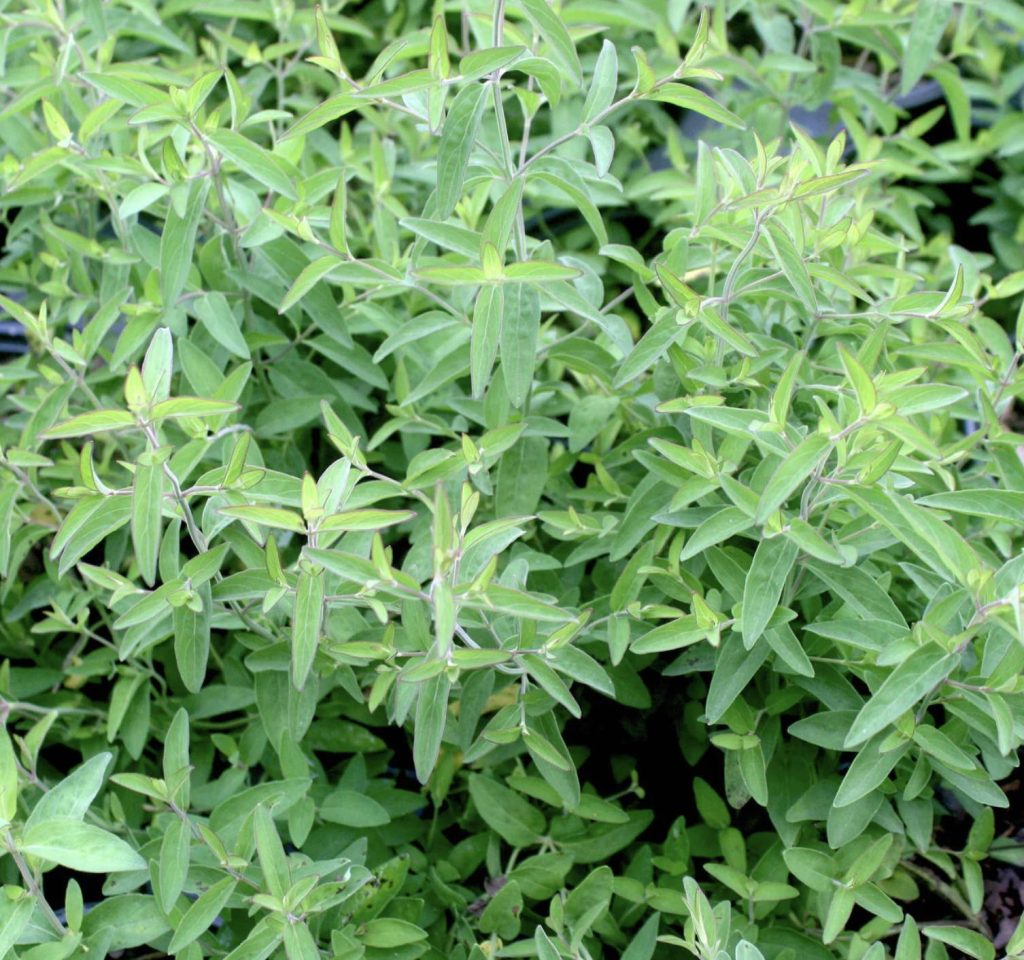 [3]https://www.rareroots.com/products/pycnanthemum-flexulosum" class="wp-image-544437" srcset="https://www.gardensall.com/wp-content/uploads/2023/06/Appalachian-Mountain-Mint-Pycnanthemum-flexuosum-rareroots.com_-1024x960.jpg 1024w, https://www.gardensall.com/wp-content/uploads/2023/06/Appalachian-Mountain-Mint-Pycnanthemum-flexuosum-rareroots.com_-300x281.jpg 300w, https://www.gardensall.com/wp-content/uploads/2023/06/Appalachian-Mountain-Mint-Pycnanthemum-flexuosum-rareroots.com_-768x720.jpg 768w, https://www.gardensall.com/wp-content/uploads/2023/06/Appalachian-Mountain-Mint-Pycnanthemum-flexuosum-rareroots.com_-960x900.jpg 960w, https://www.gardensall.com/wp-content/uploads/2023/06/Appalachian-Mountain-Mint-Pycnanthemum-flexuosum-rareroots.com_-1080x1013.jpg 1080w, https://www.gardensall.com/wp-content/uploads/2023/06/Appalachian-Mountain-Mint-Pycnanthemum-flexuosum-rareroots.com_-1200x1125.jpg 1200w, https://www.gardensall.com/wp-content/uploads/2023/06/Appalachian-Mountain-Mint-Pycnanthemum-flexuosum-rareroots.com_-150x141.jpg 150w, https://www.gardensall.com/wp-content/uploads/2023/06/Appalachian-Mountain-Mint-Pycnanthemum-flexuosum-rareroots.com_.jpg 1506w" sizes="(max-width: 760px) calc(100vw - 96px), 720px" />
[3]https://www.rareroots.com/products/pycnanthemum-flexulosum" class="wp-image-544437" srcset="https://www.gardensall.com/wp-content/uploads/2023/06/Appalachian-Mountain-Mint-Pycnanthemum-flexuosum-rareroots.com_-1024x960.jpg 1024w, https://www.gardensall.com/wp-content/uploads/2023/06/Appalachian-Mountain-Mint-Pycnanthemum-flexuosum-rareroots.com_-300x281.jpg 300w, https://www.gardensall.com/wp-content/uploads/2023/06/Appalachian-Mountain-Mint-Pycnanthemum-flexuosum-rareroots.com_-768x720.jpg 768w, https://www.gardensall.com/wp-content/uploads/2023/06/Appalachian-Mountain-Mint-Pycnanthemum-flexuosum-rareroots.com_-960x900.jpg 960w, https://www.gardensall.com/wp-content/uploads/2023/06/Appalachian-Mountain-Mint-Pycnanthemum-flexuosum-rareroots.com_-1080x1013.jpg 1080w, https://www.gardensall.com/wp-content/uploads/2023/06/Appalachian-Mountain-Mint-Pycnanthemum-flexuosum-rareroots.com_-1200x1125.jpg 1200w, https://www.gardensall.com/wp-content/uploads/2023/06/Appalachian-Mountain-Mint-Pycnanthemum-flexuosum-rareroots.com_-150x141.jpg 150w, https://www.gardensall.com/wp-content/uploads/2023/06/Appalachian-Mountain-Mint-Pycnanthemum-flexuosum-rareroots.com_.jpg 1506w" sizes="(max-width: 760px) calc(100vw - 96px), 720px" />Beadle’s Mountain Mint (Pycnanthemum beadlei)
- Hardiness Zone: Zones 5-8
- Bloom Time: Mid to late summer
- Harvest Time: Late summer when leaves are fully grown
- Sun: Full sun to partial shade
- Water: Moderate; tolerates dry conditions once established
- Soil: Adaptable to various soil conditions, but prefers well-drained soil
- Invasive: No
Beadle’s Mountain Mint (Pycnanthemum beadlei), named in honor of the American botanist Chauncey Delos Beadle, is native to the southeastern United States. This variety is less common than others but is gaining popularity for its resistance to deer and its attractiveness to butterflies, bees, and other pollinators.
Beadle’s Mountain Mint features narrow leaves and small, whitish to pale lavender flowers. Like other Mountain Mints, it emits a strong, minty aroma when the leaves are crushed. This variety is known for its adaptability and can tolerate dry conditions once established, making it a good option for drought-prone gardens or low-maintenance landscapes. It is not considered invasive and tends to stay within its planting bounds, making it a good choice for gardeners who want the benefits of mint without the concern of it taking over their garden.

Broadleaf Mountain Mint (Pycnanthemum latifolium)
- Hardiness Zone: 5-9
- Bloom Time: July to September
- Harvest Time: Late summer
- Sun: Full to partial
- Water: Moderate
- Soil: Prefers moist, well-drained soils
- Invasive: Can be moderately aggressive if not controlled
Broadleaf Mountain Mint is known for its broad, dark green leaves and profuse white flowers. The plant has a strong, minty aroma and attracts a diverse array of pollinators, making it a popular choice for naturalistic and pollinator gardens.
EDITOR’S NOTE: No definite image could be found. If you have it, we’d love to see it and publish it here with credit to you. Just send it via email.
Cluster Mountain Mint (Pycnanthemum muticum)
- Hardiness Zone: 4-8
- Bloom Time: June to September
- Harvest Time: Late summer
- Sun: Full to partial
- Water: Moderate
- Soil: Well-drained, can tolerate a variety of soil types
- Invasive: Less invasive than other mints, but can still spread if not kept in check
Cluster Mountain Mint gets its name from its dense clusters of tiny, white, fragrant flowers. This species has a strong minty aroma and is highly attractive to bees and butterflies, making it a great addition to any pollinator garden.
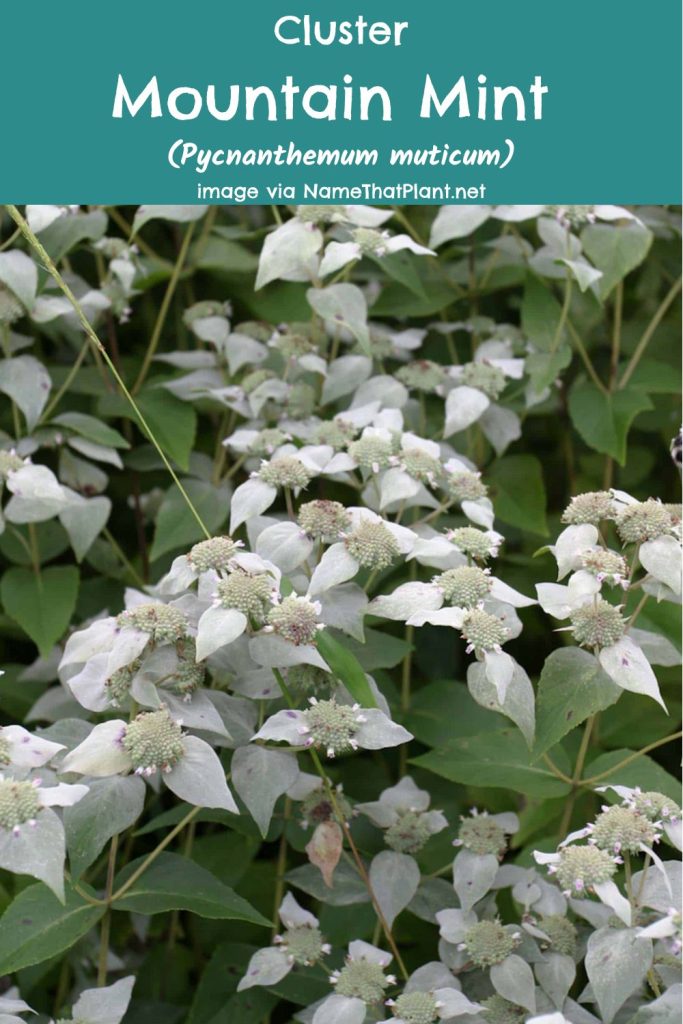
Hairy Mountain Mint (Pycnanthemum pilosum)
- Hardiness Zone: 5-8
- Bloom Time: June to August
- Harvest Time: Late summer
- Sun: Full to partial
- Water: Moderate
- Soil: Prefers well-drained loams
- Invasive: Can be moderately aggressive if not controlled
Hairy Mountain Mint is known for its distinctive hairy stems and leaves, which give the plant a grayish appearance. The white to lavender flowers are highly attractive to a wide variety of pollinators, and the leaves have a potent, minty aroma when crushed.

Hoary Mountain Mint (Pycnanthemum incanum)
- Hardiness Zone: 4-8
- Bloom Time: June to August
- Harvest Time: Late summer
- Sun: Full to partial
- Water: Moderate
- Soil: Well-drained, can tolerate a variety of soil types
- Invasive: Less invasive than other mints, but can still spread if not kept in check
Hoary Mountain Mint is a highly aromatic, perennial herb known for its silvery-gray leaves and stems. The plant produces clusters of tiny white flowers that are very attractive to pollinators, making it a favorite for pollinator gardens.
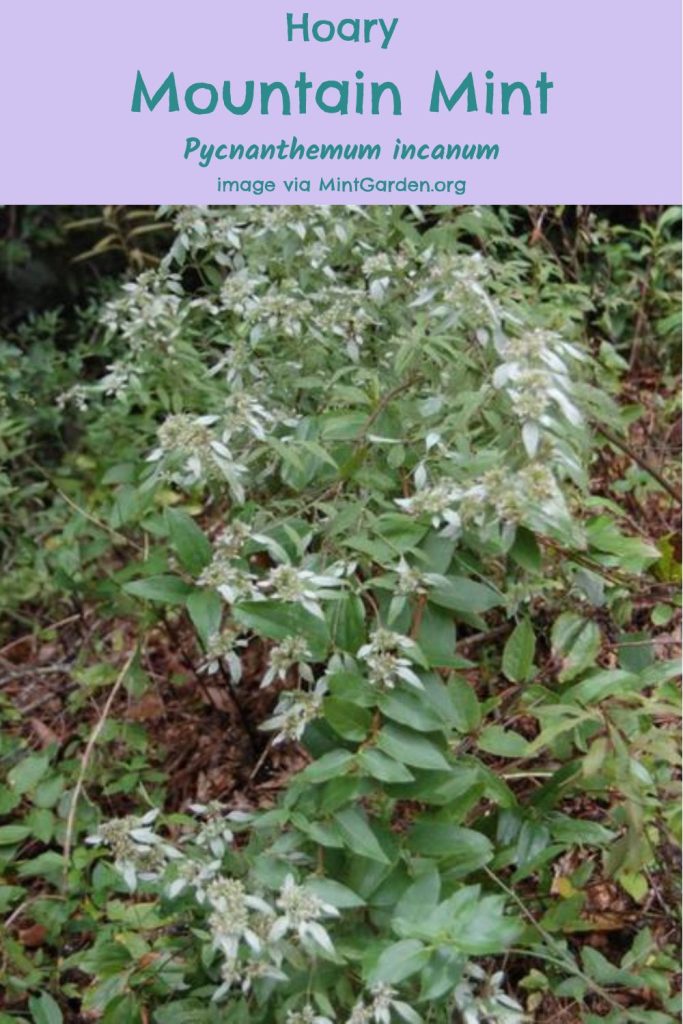
Long-Leaved Mountain Mint (Pycnanthemum longifolium)
- Hardiness Zone: Zones 5-8
- Bloom Time: Mid to late summer
- Harvest Time: Late summer when leaves are fully grown
- Sun: Full sun to partial shade
- Water: Moderate; tolerates dry conditions once established
- Soil: Prefers well-drained soil, but adaptable to a wide range of soil conditions
- Invasive: No
Long-Leaved Mountain Mint, slender-leaf and narrowleaf mint, (Pycnanthemum longifolium), is native to North America, predominantly the Eastern United States. As its name suggests, this species is characterized by its long, lance-shaped leaves, which emit a potent, minty aroma when crushed.
Blooming in mid to late summer, the Long-Leaved Mountain Mint produces clusters of small, white flowers that are highly attractive to a variety of pollinators, including bees, butterflies, and hummingbirds.
Long-Leaved Mountain Mint is a hardy plant that thrives in full sun to partial shade and is relatively drought-tolerant once established. Its adaptability to a range of soil conditions makes it a versatile addition to gardens, and it’s not considered invasive, which allows it to be a part of a garden or landscape without the risk of it taking over.
EDITOR’S NOTE:
Narrow Leaf, slender leaf and long leaf varieties of mountain mint are thought to be similar names for the same plant, known botanically as (Pycnanthemum tenuifolium). So no definite image could be found for certain. If you have it, and are certain about the identification, we’d love to see it and publish it here with credit to you. Just send it via email.
Narrow Leaf Mountain Mint (Pycnanthemum tenuifolium)
- Hardiness Zone: 4-8
- Bloom Time: June to September
- Harvest Time: Late summer
- Sun: Full to partial
- Water: Moderate
- Soil: Well-drained, prefers slightly acidic to neutral soils
- Invasive: Less invasive than other mints, but can still spread if not kept in check
Narrow Leaf Mountain Mint, aka slender mountain mint, is distinguished by its narrow, needle-like leaves and clusters of small white flowers. The plant has a strong minty scent and is highly attractive to pollinators, especially bees and butterflies.

Short Toothed (aka Basil) Mountain Mint (Pycnanthemum clinopodioides)
- Hardiness Zone: Zones 5-8
- Bloom Time: Mid to late summer
- Harvest Time: Late summer when leaves are fully grown
- Sun: Full sun to partial shade
- Water: Moderate; tolerates dry conditions once established
- Soil: Prefers well-drained soil, but adaptable to a wide range of soil conditions
- Invasive: No
Short Toothed Mountain Mint, also known as Wild Basil or Basil Mountain Mint (Pycnanthemum clinopodioides), is a North American native, predominantly found in the Eastern United States. It’s given the name ‘clinopodioides’ due to its resemblance to the plants in the Clinopodium genus, commonly known as ‘wild basil’.
This species features serrated, short-toothed leaves and clusters of tiny, white, fragrant flowers. Like other Mountain Mints, the foliage emits a strong, pleasant, minty aroma when crushed, and the flowers are attractive to a host of pollinators, from bees to butterflies.
Short Toothed Mountain Mint thrives in full sun to partial shade and prefers well-drained soils, though it demonstrates a good degree of adaptability. It’s also considered drought-tolerant once established. As it is not invasive, it can be incorporated into a garden or landscape without concern of it overtaking other plants.
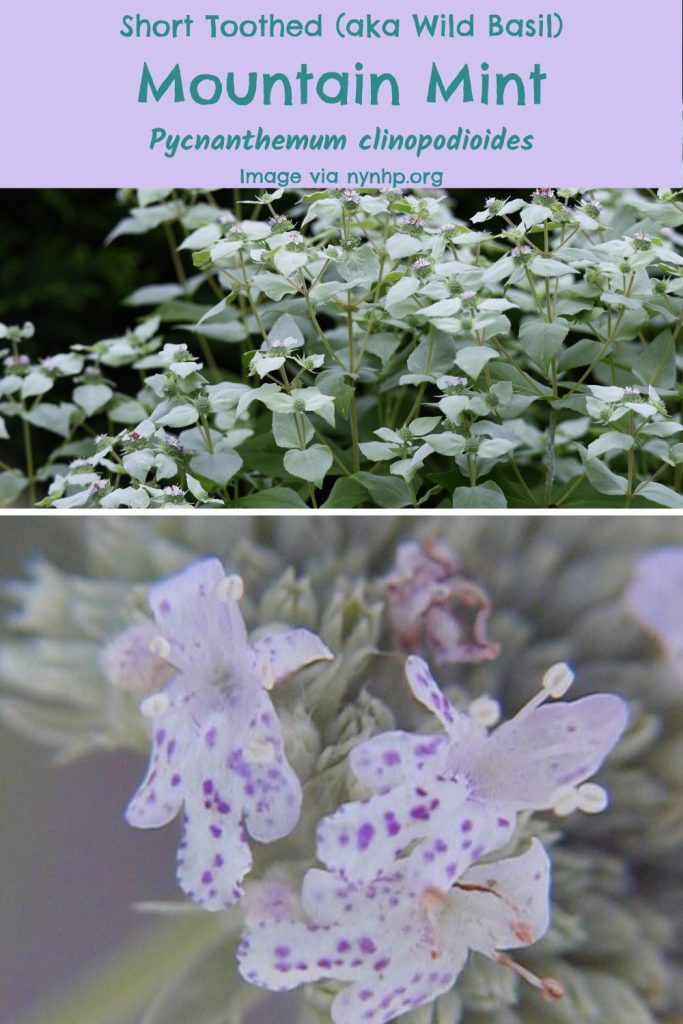
Virginia Mountain Mint (Pycnanthemum virginianum)
- Hardiness Zone: 3-8
- Bloom Time: July to September
- Harvest Time: Late summer
- Sun: Full to partial
- Water: Moderate
- Soil: Well-drained, can tolerate a variety of soil types
- Invasive: Can be moderately aggressive if not controlled
Mountain Mint, also known as Virginia Mountain Mint, is a common and widespread species native to North America. The plant is highly valued for its aromatic leaves and its clusters of small, white flowers that are very attractive to pollinators.
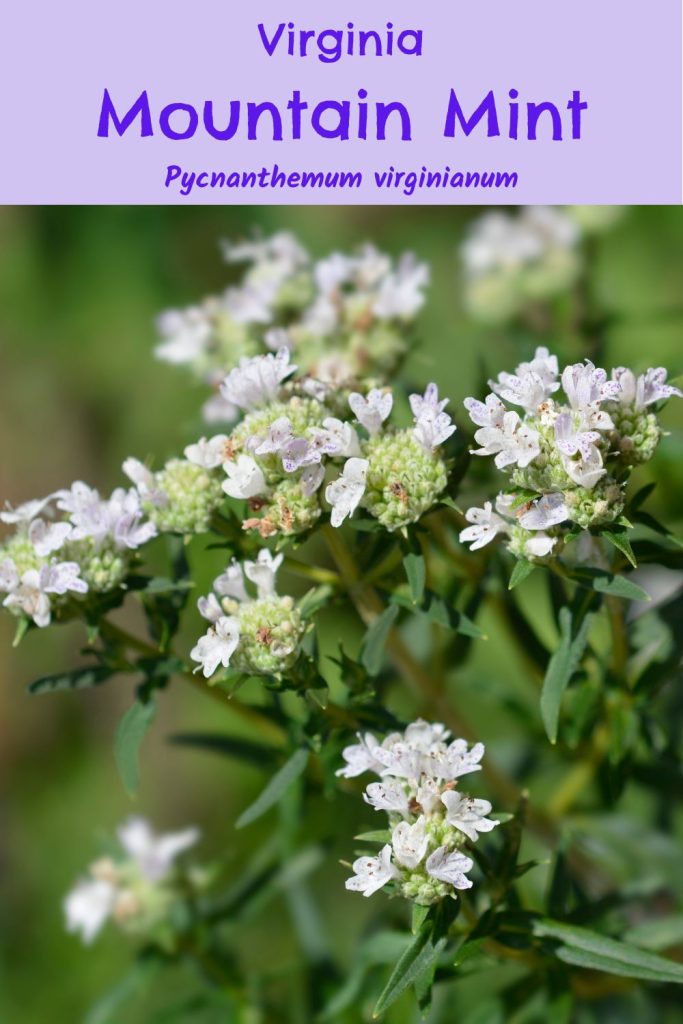
Pruning and Harvesting Mountain Mint
Harvesting and pruning mint is pretty much the same as harvesting mountain mint. It can be done throughout the growing season, beginning in spring for the freshest and most potent herbal oils for flavor and health benefits.
A Mint to Grow
Bottom line, growing mint is wonderful, especially if you’re growing the more invasive varieties in pots. See als, growing lemon balm.
The unique characteristics and uses of mountain mint make it a beneficial and distinctive addition to the yard or garden, either planted in the ground or in pots. We hope you enjoy it!
I’m LeAura Alderson, a garden, herb and plant enthusiast with a passion for discovering the many edible and medicinal benefits of the plants all around us, including the weeds! I’m a writer, editor and media publisher for our family of websites.
While I was certified in fitness and life coaching, I am NOT a health practitioner. However, I’m a lifelong health enthusiast, with a keen interest in healthy, organic foods and making home remedies and the content we share is from our own experience and usage as well as that extracted from scientific research so that you can explore further on your own.
Always seek the advice and guidance of your health practitioners first and foremost.
As a family we’re steadily expanding our gardening, experimentation and knowledge around all things gardening, edible landscaping, fresh organic foods and self sustainability with farming in our future. I also own and manage iCreateDaily.com, a site all about transformation through creation, and the power of positivity, optimism and mindset.
References
| ↑1, ↑2 | https://extension.psu.edu/programs/master-gardener/counties/lancaster/pollinator-friendly-garden-certification/pollinator-trial-results-2013 |
|---|---|
| ↑3 | https://www.rareroots.com/products/pycnanthemum-flexulosum |
| ↑4 | https://www.rareroots.com/products/pycnanthemum-flexulosum |
| ↑5 | https://guides.nynhp.org/basil-mountain-mint/ |

